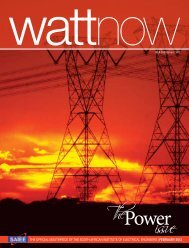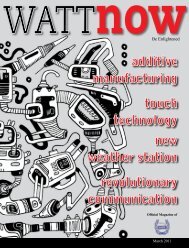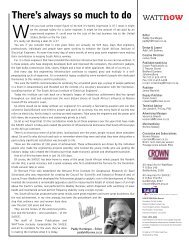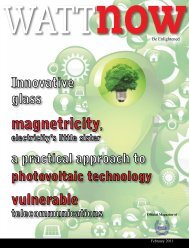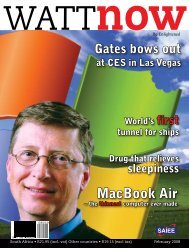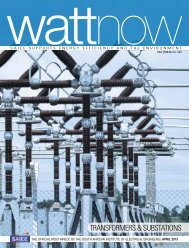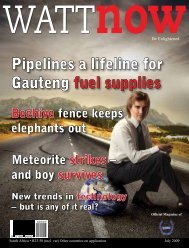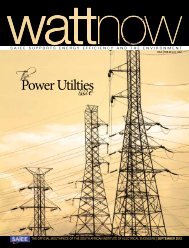Cut electricity consumption with automation - Watt Now Magazine
Cut electricity consumption with automation - Watt Now Magazine
Cut electricity consumption with automation - Watt Now Magazine
Create successful ePaper yourself
Turn your PDF publications into a flip-book with our unique Google optimized e-Paper software.
As to the scope for energy efficiency in South Africa, which is<br />
oft reported as one of the world’s most energy inefficient societies,<br />
Statham says it depends on who you speak <strong>with</strong>. The former CEO<br />
of AngloGold Ashanti, Bobby Godsel was sanguine about the 10%<br />
target for reduction of <strong>electricity</strong>, and suggested it should be higher,<br />
but an aluminium sector executive who claims to have focused on the<br />
efficiencies of that company’s biggest cost inputs, is appalled at such<br />
a suggestion.<br />
“To generalise, South Africans are not particularly energy aware,”<br />
Statham says. “Executives don’t instruct their building managers to<br />
ensure office building lights are switched off at night, a directive they<br />
would personally ensure was carried out if they were really concerned<br />
about energy efficiency. Shopping malls can cut the use of lighting<br />
significantly <strong>with</strong>out any ill effects. Pump manufacturers lecture on<br />
how much <strong>electricity</strong> could be saved if only the pumps they sell were<br />
maintained adequately and the sludge that collects in these cleaned<br />
out periodically.” Compare this <strong>with</strong> the EU where people switch<br />
off the lights when they leave a room and escalators have motion<br />
detectors and only activate when there is someone to convey.<br />
“South Africa got a shock earlier this year, but there has been no<br />
real attitude change, and if someone is not energy aware at home it is<br />
unlikely he or she will be at the office or factory.”<br />
Statham does not believe the solution lies in a step change in the<br />
price of <strong>electricity</strong>, nor in compulsory load shedding. “People do not<br />
respond well to measures they see as punitive. Further, an affluent<br />
household will complain about the doubling of the unit cost of<br />
<strong>electricity</strong> to about 40c, but this will not have a material impact and<br />
change habits, while such a hike will have a crippling effect on the<br />
poorer population.”<br />
Nor does Statham believe intelligent meters, which would have to be<br />
rolled out in their millions at high cost, <strong>with</strong> potentially unattainable<br />
near term logistical constraints, are the solution.<br />
“A solution for changing residential <strong>electricity</strong> demand behaviour<br />
already exists. It was implemented for what will be a scarcer<br />
commodity in South Africa over the longer term, water. It is the use<br />
of exponentially increasing tariffs, where the first units are cheap, and<br />
the more units used the steeper the price escalation. No demanding roll<br />
out of technology is required as existing metering systems and methods<br />
already provide the information required for implementation.<br />
Statham says instead that the biggest threat to solving the <strong>electricity</strong><br />
crisis in South Africa is a culture of blame. “Various groups are trying<br />
to do things in isolation rather than approach the problem as SA<br />
Incorporated.<br />
“Unfortunately the government and Eskom have taken the approach<br />
of doing it all themselves. In reality they suffer from skill shortages<br />
and a lack of capacity, and the private sector in turn has been reluctant<br />
to come forward <strong>with</strong> solutions.”<br />
Statham refers to something a former CEO of Eskom, Ian McRae,<br />
who demonstrated leadership and foresight during his tenure at<br />
Eskom, told him. “The insecure man needs answers to all, while the<br />
secure man simply needs to know where to find the answers.”<br />
History also holds a lesson. When in the past Eskom, during a<br />
large generation capacity expansion phase, built Matla power station,<br />
few recall that it was not Eskom that provided the site management<br />
team that built that power station. It was done by an independent<br />
international contractor. “One can take if further. If there is a shortage<br />
of skills in managing a power station, why not bring in a private<br />
contractor.” Companies in the mining sector bring in specialist plant<br />
operators, when they don’t have the capacity or inclination to operate<br />
their own plants, and the power sector could do something similar. In<br />
addition, importing the necessary engineering skills from offshore is<br />
a lot less damaging to South Africa’s overall job creation prospects<br />
than having situations ferment that sees waves of emigration.”<br />
Business should not be unwilling to offer solutions and Eskom and<br />
the government should not be too proud to accept them.<br />
July 2008<br />
10



